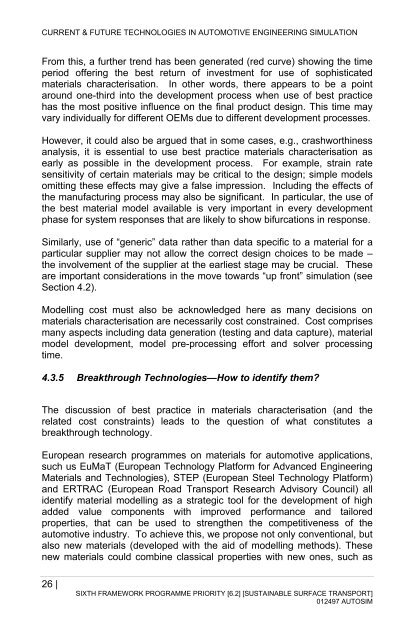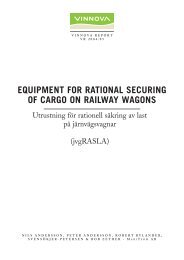Download - Autosim Autosim
Download - Autosim Autosim
Download - Autosim Autosim
You also want an ePaper? Increase the reach of your titles
YUMPU automatically turns print PDFs into web optimized ePapers that Google loves.
CURRENT & FUTURE TECHNOLOGIES IN AUTOMOTIVE ENGINEERING SIMULATION<br />
From this, a further trend has been generated (red curve) showing the time<br />
period offering the best return of investment for use of sophisticated<br />
materials characterisation. In other words, there appears to be a point<br />
around one-third into the development process when use of best practice<br />
has the most positive influence on the final product design. This time may<br />
vary individually for different OEMs due to different development processes.<br />
However, it could also be argued that in some cases, e.g., crashworthiness<br />
analysis, it is essential to use best practice materials characterisation as<br />
early as possible in the development process. For example, strain rate<br />
sensitivity of certain materials may be critical to the design; simple models<br />
omitting these effects may give a false impression. Including the effects of<br />
the manufacturing process may also be significant. In particular, the use of<br />
the best material model available is very important in every development<br />
phase for system responses that are likely to show bifurcations in response.<br />
Similarly, use of “generic” data rather than data specific to a material for a<br />
particular supplier may not allow the correct design choices to be made –<br />
the involvement of the supplier at the earliest stage may be crucial. These<br />
are important considerations in the move towards “up front” simulation (see<br />
Section 4.2).<br />
Modelling cost must also be acknowledged here as many decisions on<br />
materials characterisation are necessarily cost constrained. Cost comprises<br />
many aspects including data generation (testing and data capture), material<br />
model development, model pre-processing effort and solver processing<br />
time.<br />
4.3.5 Breakthrough Technologies—How to identify them?<br />
The discussion of best practice in materials characterisation (and the<br />
related cost constraints) leads to the question of what constitutes a<br />
breakthrough technology.<br />
European research programmes on materials for automotive applications,<br />
such us EuMaT (European Technology Platform for Advanced Engineering<br />
Materials and Technologies), STEP (European Steel Technology Platform)<br />
and ERTRAC (European Road Transport Research Advisory Council) all<br />
identify material modelling as a strategic tool for the development of high<br />
added value components with improved performance and tailored<br />
properties, that can be used to strengthen the competitiveness of the<br />
automotive industry. To achieve this, we propose not only conventional, but<br />
also new materials (developed with the aid of modelling methods). These<br />
new materials could combine classical properties with new ones, such as<br />
26 |<br />
SIXTH FRAMEWORK PROGRAMME PRIORITY [6.2] [SUSTAINABLE SURFACE TRANSPORT]<br />
012497 AUTOSIM
















